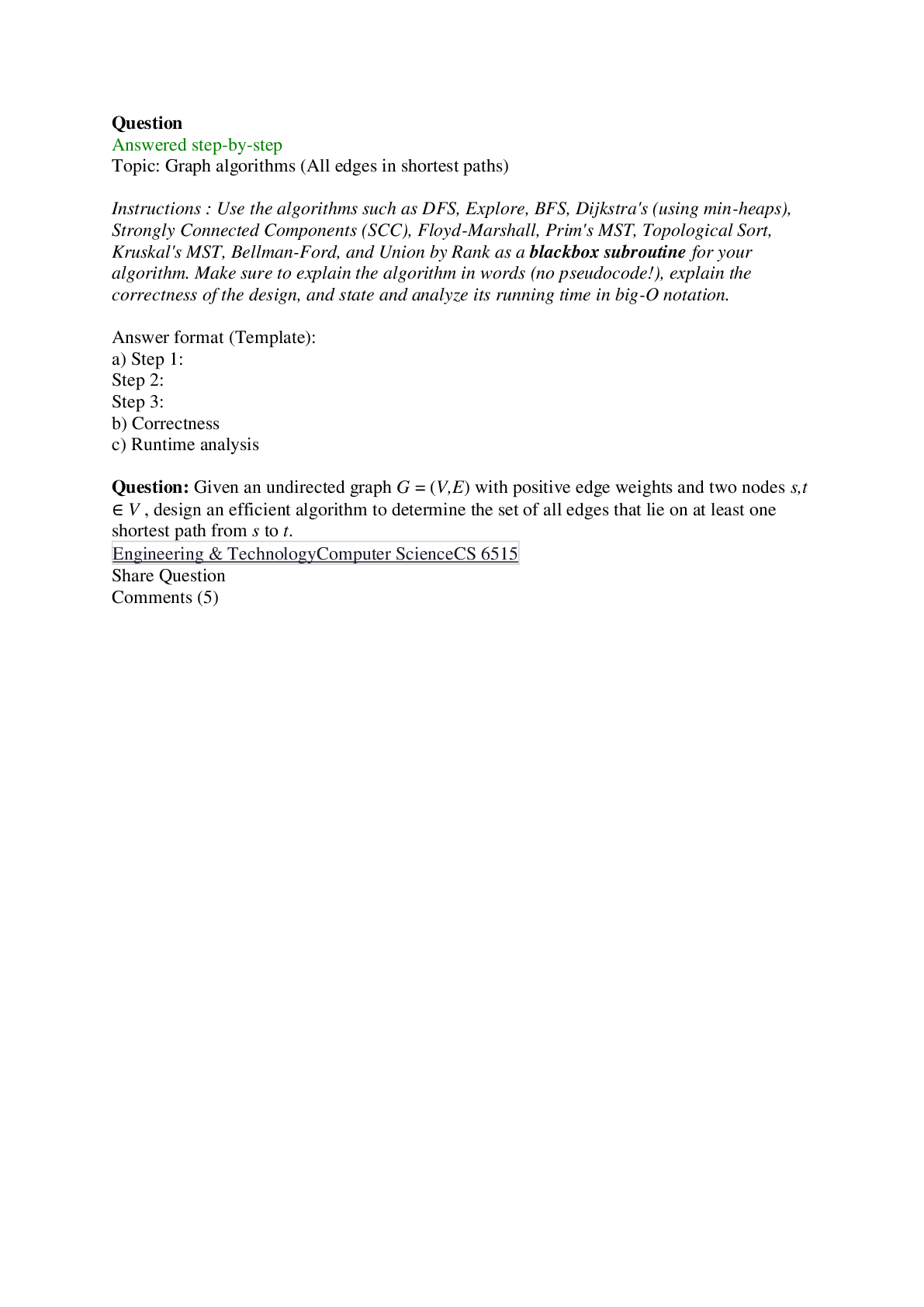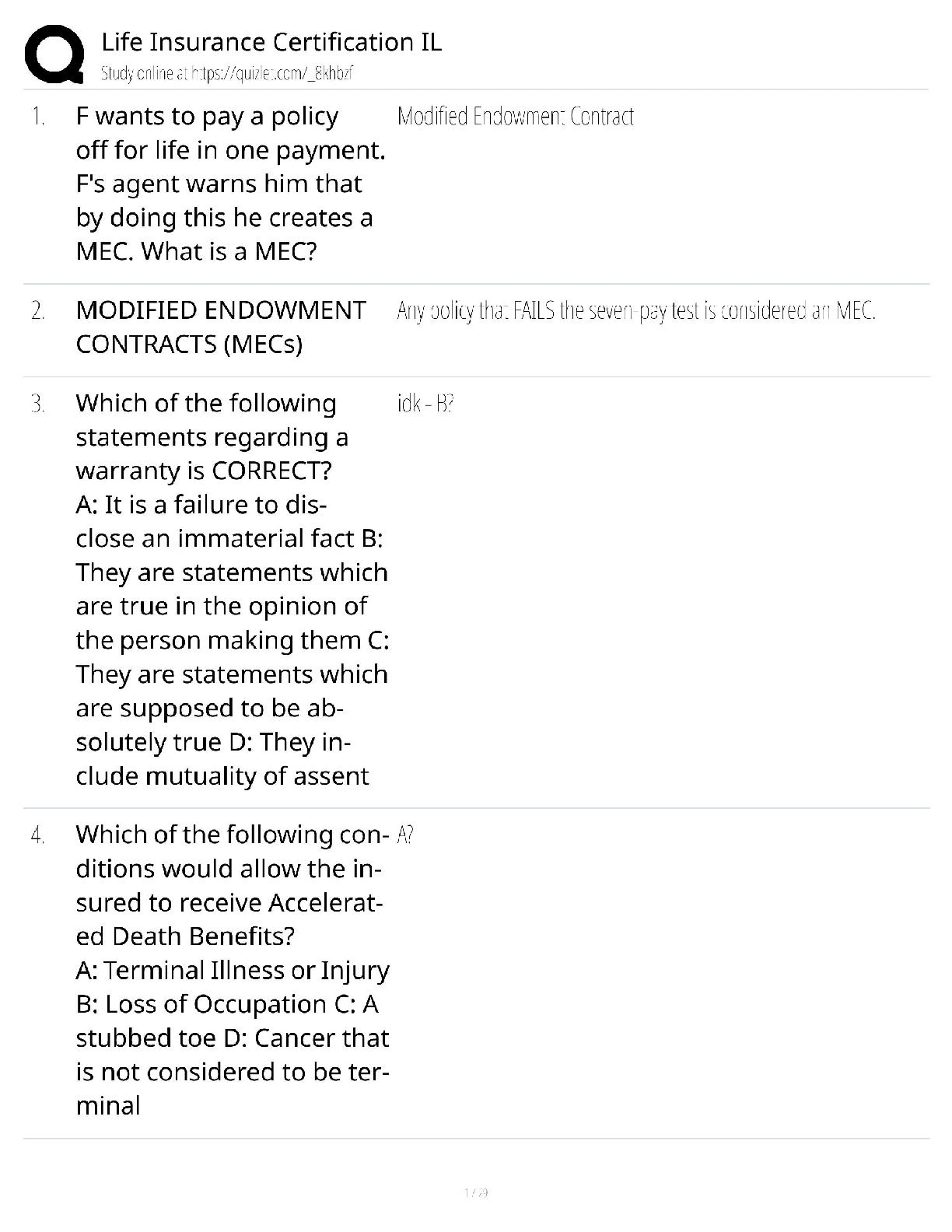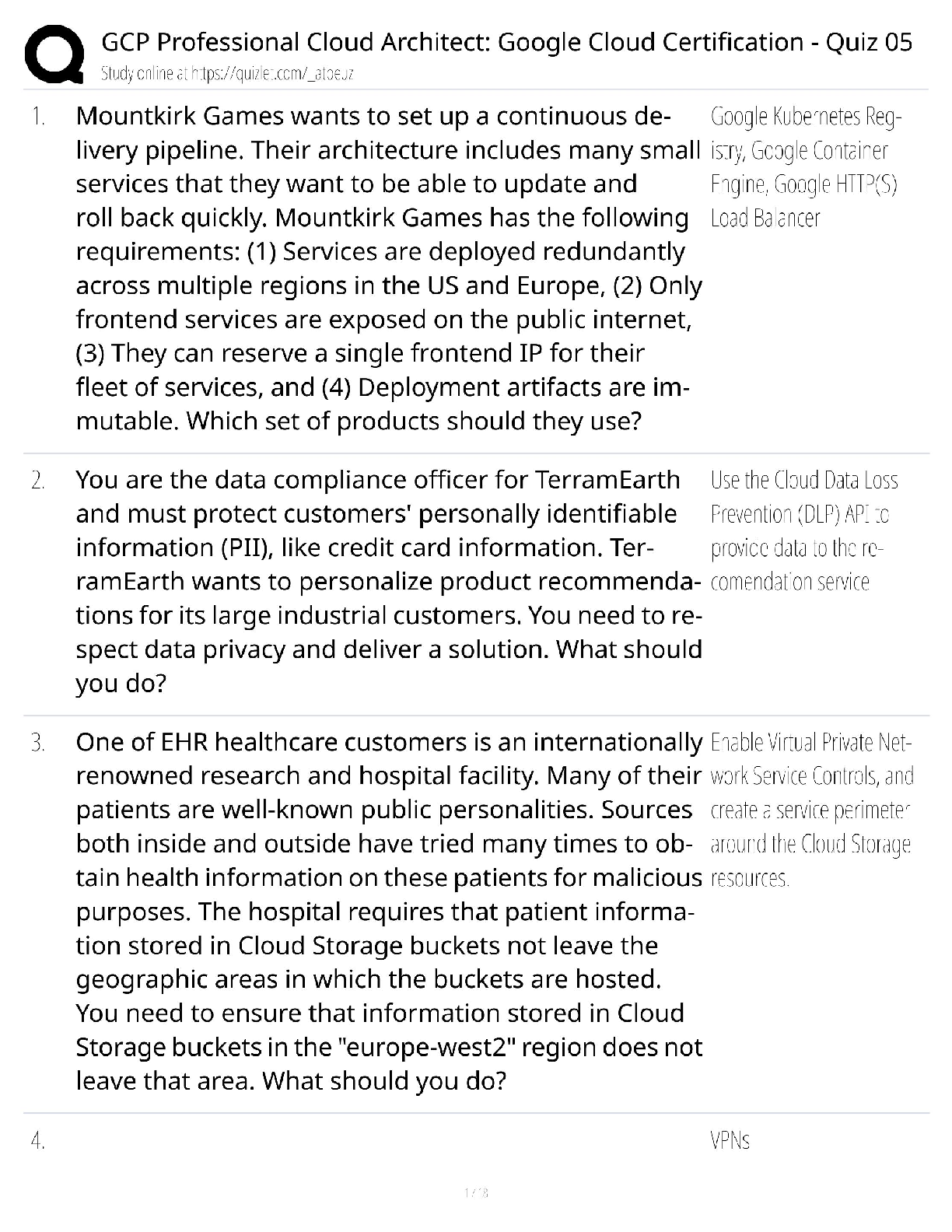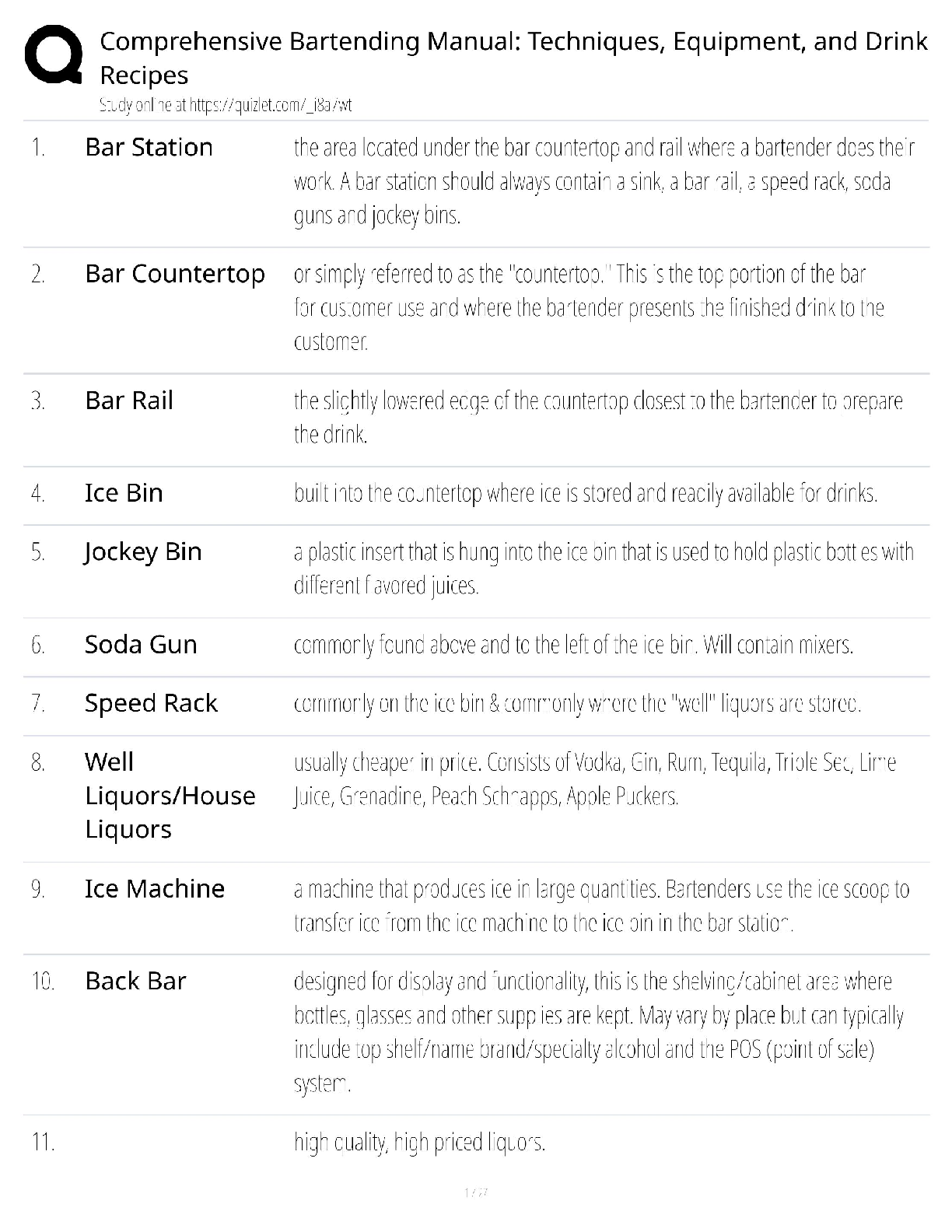Accounting > QUESTIONS & ANSWERS > CHAPTER 17 INVESTMENTS IFRS questions are available at the end of this chapter WITH CORRECT ANSWERS (All)
CHAPTER 17 INVESTMENTS IFRS questions are available at the end of this chapter WITH CORRECT ANSWERS
Document Content and Description Below
1. Debt securities include corporate bonds and convertible debt, but not U.S. government securities. Ans: F, LO: 1, Bloom: K, Difficulty: Easy, Min: 1, AACSB: AACSB: Communication, AICPA BB: None, A ... ICPA FN: Reporting, AICPA PC: Communication, IMA: Reporting, IFRS: None 2. Trading securities are securities bought and held primarily for sale in the near term to generate income on short-term price differences. Ans: T, LO: 1, Bloom: K, Difficulty: Easy, Min: 1, AACSB: Communication, AICPA BB: None, AICPA FN: Reporting, AICPA PC: Communication, IMA: Reporting, IFRS: None 3. Unrealized holding gains and losses are recognized in net income for available-for-sale debt securities. Ans: F, LO: 1, Bloom: K, Difficulty: Easy, Min: 1, AACSB: Communication, AICPA BB: None, AICPA FN: Reporting, AICPA PC: Communication, IMA: Reporting, IFRS: None 4. A company can classify a debt security as held-to-maturity if it has the positive intent to hold the securities to maturity. Ans: F, LO: 1, Bloom: K, Difficulty: Easy, Min: 1, AACSB: Communication, AICPA BB: None, AICPA FN: Reporting, AICPA PC: Communication, IMA: Reporting, IFRS: None 5. Companies do not report changes in the fair value of available-for-sale debt securities as income until the security is sold. Ans: T, LO: 1, Bloom: K, Difficulty: Moderate, Min: 1, AACSB: Analytic, AICPA BB: None, AICPA FN: Measurement, AICPA PC: Problem Solving, IMA: Reporting, IFRS: None 6. The Fair Value Adjustment account has a normal credit balance. Ans: F, LO: 1, Bloom: K, Difficulty: Easy, Min: 1, AACSB: Analytic, AICPA BB: None, AICPA FN: Measurement, AICPA PC: Problem Solving, IMA: Reporting, IFRS: None 7. Companies report trading securities at fair value, with unrealized holding gains and losses reported in net income. Ans: T, LO: 1, Bloom: K, Difficulty: Moderate, Min: 1, AACSB: Analytic, AICPA BB: None, AICPA FN: Reporting, AICPA PC: Communication, IMA: Reporting, IFRS: None 8. Equity security holdings between 20 and 50 percent indicates that the investor has a controlling interest over the investee. Ans: F, LO: 2, Bloom: K, Difficulty: Easy, Min: 1, AACSB: Communication, AICPA BB: None, AICPA FN: Reporting, AICPA PC: Communication, IMA: Reporting, IFRS: None 9. The Unrealized Holding Gain/Loss—Income account for equity securities is reported as a part of other comprehensive income. Ans: F, LO: 2, Bloom: K, Difficulty: Easy, Min: 1, AACSB: Communication, AICPA BB: None, AICPA FN: Reporting, AICPA PC: Communication, IMA: Reporting, IFRS: None 10. Significant influence over an investee may be indicated by material intercompany transactions and interchange of managerial personnel. Ans: T, LO: 3, Bloom: K, Difficulty: Moderate, Min: 1, AACSB: Analytic, AICPA BB: None, AICPA FN: Measurement, AICPA PC: Problem Solving, IMA: Reporting, IFRS: None 11. The accounting profession has concluded that an investment of 50 percent or more of the voting stock of an investee should lead to a presumption of only significant influence over an investee. Ans: F, LO: 3, Bloom: K, Difficulty: Moderate, Min: 1, AACSB: Analytic, AICPA BB: None, AICPA FN: Measurement, AICPA PC: Problem Solving, IMA: Reporting, IFRS: None 17 - 7 Test Bank for Intermediate Accounting, Sixteenth Edition 12. All cash dividends received by an investor from the investee decrease the investment’s carrying value under the equity method. Ans: T, LO: 3, Bloom: C, Difficulty: Moderate, Min: 1, AACSB: Analytic, AICPA BB: None, AICPA FN: Measurement, AICPA PC: Problem Solving, IMA: Reporting, IFRS: None 13. Under the fair value method, the investor reports as revenue its share of the net income reported by the investee. Ans: F, LO: 3, Bloom: K, Difficulty: Easy, Min: 1, AACSB: Analytic, AICPA BB: None, AICPA FN: Measurement, AICPA PC: Problem Solving, IMA: Reporting, IFRS: None 14. A controlling interest occurs when one corporation acquires a voting interest of more than 50 percent in another corporation. Ans: T, LO: 3, Bloom: K, Difficulty: Easy, Min: 1, AACSB: Analytic, AICPA BB: None, AICPA FN: Measurement, AICPA PC: Problem Solving, IMA: Reporting, IFRS: None 15. Companies may not use the fair value option for investments that follow the equity method of accounting. Ans: F, LO: 4, Bloom: K, Difficulty: Moderate, Min: 1, AACSB: Analytic, AICPA BB: None, AICPA FN: Measurement, AICPA PC: Problem Solving, IMA: Reporting, IFRS: None 16. Changes in the fair value of a company's available-for-sale debt instruments are included as part of earnings in any given period. Ans: T, LO: 4, Bloom: K, Difficulty: Easy, Min: 1, AACSB: Analytic, AICPA BB: None, AICPA FN: Measurement, AICPA PC: Problem Solving, IMA: Reporting, IFRS: None 17. If a decline in a security’s value is judged to be temporary, a company needs to write down the cost basis of the individual security to a new cost basis. Ans: F, LO: 4, Bloom: K, Difficulty: Moderate, Min: 1, AACSB: Analytic, AICPA BB: None, AICPA FN: Measurement, AICPA PC: Problem Solving, IMA: Reporting, IFRS: None 18. A reclassification adjustment is necessary when a company reports realized gains/losses as part of net income but also shows unrealized gains/losses as part of other comprehensive income. Ans: T, LO: 4, Bloom: K, Difficulty: Moderate, Min: 1, AACSB: Analytic, AICPA BB: None, AICPA FN: Measurement, AICPA PC: Problem Solving, IMA: Reporting, IFRS: None 19. If a company transfers held-to-maturity securities to available-for-sale securities, the unrealized gain or loss is recognized in income. Ans: F, LO: 4, Bloom: K, Difficulty: Easy, Min: 1, AACSB: Analytic, AICPA BB: None, AICPA FN: Measurement, AICPA PC: Problem Solving, IMA: Reporting, IFRS: None *20. One requirement related to fair value disclosure is that both the cost and the fair value of all instruments be reported in the notes to the financial statements. Ans: T, LO: 8, Bloom: C, Difficulty: Easy, Min: 1, AACSB: Analytic, AICPA BB: None, AICPA FN: Measurement, AICPA PC: Problem Solving, IMA: Reporting, IFRS: None True-False Answers—Conceptual Item Ans. Item Ans. Item Ans. Item Ans. 1. F 6. F 11. F 16. T 2. T 7. T 12. T 17. F 3. F 8. F 13. F 18. T 4. F 9. F 14. T 19. F 5. T 10. T 15. F *20. T 17 - 8 Investments MULTIPLE CHOICE—Conceptual 21. Which of the following is not a debt security? a. Convertible bonds b. Commercial paper c. Loans receivable d. All of these are debt securities. Ans: C, LO: 1, Bloom: K, Difficulty: Easy, Min: 2, AACSB: Communication, AICPA BB: None, AICPA FN: Reporting, AICPA PC: Communication, IMA: Reporting, IFRS: None 22. A correct valuation for debt securities is a. available-for-sale at amortized cost. b. held-to-maturity at amortized cost. c. held-to-maturity at fair value. d. None of these answers are correct. Ans: B, LO: 1, Bloom: K, Difficulty: Easy, Min: 2, AACSB: Analytic, AICPA BB: None, AICPA FN: Measurement, AICPA PC: Problem Solving, FSA, IFRS: None 23. Securities which could be classified as held-to-maturity are a. redeemable preferred stock. b. warrants. c. municipal bonds. d. treasury stock. Ans: C, LO: 1, Bloom: K, Difficulty: Easy, Min: 2, AACSB: Communication, AICPA BB: None, AICPA FN: Reporting, AICPA PC: Communication, IMA: Reporting, IFRS: None 24. Unrealized holding gains or losses which are recognized in income are from debt securities classified as a. held-to-maturity. b. available-for-sale. c. trading. d. None of these answers are correct. Ans: C, LO: 1, Bloom: K, Difficulty: Easy, Min: 2, AACSB: Communication, AICPA BB: None, AICPA FN: Reporting, AICPA PC: Communication, IMA: Reporting, IFRS: None P25. When an investor's accounting period ends on a date that does not coincide with an interest receipt date for bonds held as an investment, the investor must a. make an adjusting entry to debit Interest Receivable and to credit Interest Revenue for the amount of interest accrued since the last interest receipt date. b. notify the issuer and request that a special payment be made for the appropriate portion of the interest period. c. make an adjusting entry to debit Interest Receivable and to credit Interest Revenue for the total amount of interest to be received at the next interest receipt date. d. do nothing special and ignore the fact that the accounting period does not coincide with the bond's interest period. Ans: A, LO: 1, Bloom: C, Difficulty: Moderate, Min: 3, AACSB: Analytic, AICPA BB: None, AICPA FN: Measurement, AICPA PC: Problem Solving, IMA: Reporting, IFRS: None 17 - 9 Test Bank for Intermediate Accounting, Sixteenth Edition S26. Debt securities that are accounted for at amortized cost, not fair value, are a. held-to-maturity debt securities. b. trading debt securities. c. available-for-sale debt securities. d. never-sell debt securities. Ans: A, LO: 1, Bloom: K, Difficulty: Easy, Min: 2, AACSB: Communication, AICPA BB: None, AICPA FN: Reporting, AICPA PC: Communication, IMA: Reporting, IFRS: None S27. Debt securities acquired by a corporation which are accounted for by recognizing unrealized holding gains or losses that are included as other comprehensive income and as a separate component of stockholders' equity are a. held-to-maturity debt securities. b. trading debt securities. c. available-for-sale debt securities. d. never-sell debt securities. Ans: C, LO: 1, Bloom: K, Difficulty: Moderate, Min: 2, AACSB: Analytic, AICPA BB: None, AICPA FN: Reporting, AICPA PC: Problem Solving, IMA: Reporting, IFRS: None S28. Use of the effective-interest method in amortizing bond premiums and discounts results in a. a greater amount of interest income over the life of the bond issue than would result from use of the straight-line method. b. a varying amount being recorded as interest income from period to period. c. a variable rate of return on the book value of the investment. d. a smaller amount of interest income over the life of the bond issue than would result from use of the straight-line method. Ans: B, LO: 1, Bloom: C, Difficulty: Moderate, Min: 2, AACSB: Analytic, AICPA BB: None, AICPA FN: Measurement, AICPA PC: Problem Solving, IMA: Reporting, IFRS: None S29. Equity securities acquired by a corporation which are accounted for by recognizing unrealized holding gains or losses are a. securities where a company has holdings of less than 20%. b. securities where a company has holdings of more than 20%. c securities where a company has holdings of between 20% and 50%. d. securities where a company has holdings of more than 50%. Ans: A, LO: 2, Bloom: K, Difficulty: Moderate, Min: 2, AACSB: Analytic, AICPA BB: None, AICPA FN: Measurement, AICPA PC: Problem Solving, IMA: Reporting, IFRS: None 30. A requirement for a security to be classified as held-to-maturity is a. ability to hold the security to m [Show More]
Last updated: 3 years ago
Preview 1 out of 50 pages
.png)
Buy this document to get the full access instantly
Instant Download Access after purchase
Buy NowInstant download
We Accept:

Reviews( 0 )
$12.00
Can't find what you want? Try our AI powered Search
Document information
Connected school, study & course
About the document
Uploaded On
Sep 04, 2022
Number of pages
50
Written in
All
Additional information
This document has been written for:
Uploaded
Sep 04, 2022
Downloads
0
Views
134


























